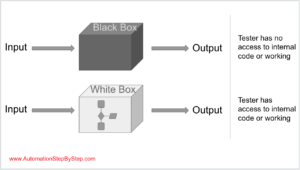It is a method of software testing that tests internal structures or workings of an application
- Clear box testing
- Open-box testing
- Glass box testing
- Transparent box testing
- Structural testing
- Code-based testing
In White box testing the internal structure, code, design and implementation of the application/product is known to the tester.
Also read – What is Black box testing
This type of testing is named so because the tester can see inside the system.

In Black box testing, the tester has no information of the inside workings and structure of the application/products and testing is done like and end-user.
White box testing is mainly implemented during unit testing but can also be done at the following levels
- Unit Testing – for testing individual units or components
- Integration Testing – for testing multiple units combined in a group
- System Testing – for testing a fully integrated system
White-box test design techniques:
- Control flow testing
- Data flow testing
- Branch testing
- Statement coverage
- Decision coverage
- Modified condition/decision coverage
- Prime path testing
- Path testing
Advantages
- Testing can be started earlier in the dev phase
- More in-depth testing can be done with access to code
- More efficient
- Less number of bugs during GUI testing
- Automation can be done
Disadvantages
- Requires skilled resources
- Requires code access
- Can be time-consuming